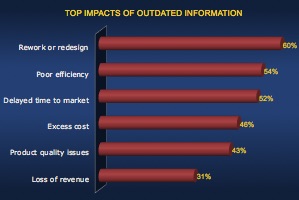 Imagine what you could do if you could get almost a third of your time back? In a guest post on the Sodius Willert blog, Michelle Boucher shares research on how much engineering time is wasted on non-value added work and explains what you can do.
Imagine what you could do if you could get almost a third of your time back? In a guest post on the Sodius Willert blog, Michelle Boucher shares research on how much engineering time is wasted on non-value added work and explains what you can do.
Focus on the Work You Enjoy
As an engineer, what gets you excited about your job? For most, it’s getting to work on really cool projects and innovating. Unfortunately, a good chunk of your time is wasted on other things, taking you away from the work you enjoy doing and the work that adds value for your company.
How Do You Limit Non-Value Added Work?
 Research from Tech-Clarity’s Reducing Non-Value Added Work in Engineering reveals that engineers waste a startling 32% on non-value added work. That’s a lot of lost opportunity. Imagine what you could do if you could get almost a third of your time back? Much of this non-value added work is related to the many manual tasks associated with managing, sharing, and finding data. Data tends to be stored in multiple places, so there is no single source of truth.
Research from Tech-Clarity’s Reducing Non-Value Added Work in Engineering reveals that engineers waste a startling 32% on non-value added work. That’s a lot of lost opportunity. Imagine what you could do if you could get almost a third of your time back? Much of this non-value added work is related to the many manual tasks associated with managing, sharing, and finding data. Data tends to be stored in multiple places, so there is no single source of truth.
Without a single source of truth, there is no traceability across the data. It then becomes practically impossible to identify the impact of an update to requirements, new design work, or changes to other parts of the design. Without traceability, changes can not automatically propagate across all product data. Instead, changes and updates become a very manual, if not impossible, process to identify everything that is impacted and update it. This is further complicated if the same data is located in multiple places. The situation creates a significant risk for outdated and conflicting data. Unfortunately, this costs the company in numerous ways, which we will explore further.
The Cost of Outdated Information
When design work is based on outdated information, error will be inevitable. These errors result in costly rework and redesign. Wasting even more time to correct these problems means poor efficiency which can delay time to market. As the design nears completion, there are fewer options to fix problems, so errors become much more expensive and time consuming to fix. Plus, with limited options, solutions may be less than ideal, which will hurt product quality or drive up cost. Of course, if problems are missed entirely, there will be even bigger quality problems in the field. The combination of poor quality, higher cost, and late to market all hurt competitiveness which can reduce revenue opportunities.
This problem gets even worse when multiple engineering disciplines are involved. When products integrate mechanical components, electronics, and embedded software, there are inherent silos.
Continue to the Sodius Willert blog for the full post.

